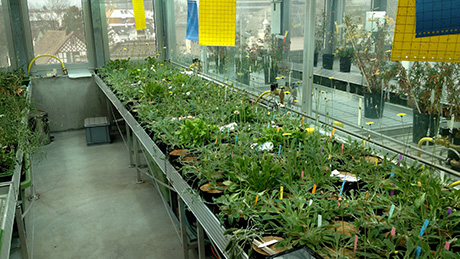Navigation auf uzh.ch
Navigation auf uzh.ch

In today’s agriculture, hybrid plants are crucial for the sufficient production of food, feed, fuel and fiber. These crosses between two different varieties are deemed particularly hardy and far more productive than their thoroughbred parent generations. Thanks to hybrid plants, the harvests from types of cereal crop, such as corn, can be more than doubled. However, the positive properties are already lost in the next generation, which is why hybrid seeds need to be reproduced annually. These crosses are costly and time-consuming and farmers are reliant on new seeds every year.
Back in the 1930s, two Russian scientists came up with a proposal to simplify this elaborate process: If the first generation of crosses, the so-called F1 hybrid, were able to reproduce asexually, it would retain their increased efficiency. Some plant species naturally reproduce by cloning their seeds, which is referred to as apomixis. The theory that apomixis might preserve the properties of hybrid plants, however, had never been tested in an experimental setup – until now: Professor Ueli Grossniklaus and his team from the Department of Plant and Microbial Biology at the University of Zurich have found proof.
“Based on hybrid plants that reproduce apomictically, we demonstrated that the offspring also exhibit the desired biological properties,” explains first author Dr. Christian Sailer. “We managed to fix the hybrids’ particular efficiency.” The plants achieve the same size and yield for at least two more generations. This is in stark contrast to the individual plants of the following generation of conventional F1 hybrids used in agriculture, which differ significantly. Sailer’s publication is a key, much-anticipated contribution towards apomixis research and its potential application as it was previously unclear whether the fixation of the genotype would suffice to preserve the advantageous properties of hybrids for generations.
For their experiments, the research team created 11 new hybrids using natural apomictic mouse-ear hawkweed (Hieracium pilosella) and reproduced them for two generations through the natural cloning of the seeds. 20 different properties were measured and tested to see if they changed from one plant generation to the next. Moreover, both generations of the same clone were grown in the greenhouse at the same time to expose them to the same environmental conditions and exclude various factors, such as temperature, water and light.
“If this special reproduction method could be used in crops, it would slash the cost of producing F1 hybrid seeds,” explains Professor Ueli Grossniklaus. “It’s not just seed producers who stand to benefit, but also subsistence farmers in developing countries.” Nowadays, these small farmers usually use less productive native crops for their own personal use. Apomictic reproduction would offer them more affordable access to more productive and hardy hybrid strains. And they would be able to use the seeds from the current harvest for sowing the following year without affecting the yield. According to Grossniklaus, however, its actual use in crops still needs to be tested in detail.
Christian Sailer, Bernhard Schmid, Ueli Grossniklaus. Apomixis allows the transgenerational fixation of phenotypes in hybrid plants. Current Biology, January 28, 2016. Doi: 10.1016/j.cub.2015.12.045